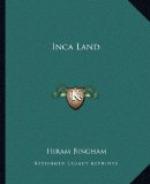On the other hand there seems to be no doubt that Espiritu Pampa in the montana does meet the requirements of the place called Vilcabamba by the companions of Captain Garcia. They speak of it as the town and valley to which Tupac Amaru, the last Inca, escaped after his forces lost the “young fortress” of Uiticos. Ocampo, doubtless wishing to emphasize the difference between it and his own metropolis, the Spanish town of Vilcabamba, calls the refuge of Tupac “Vilcabamba the old.” Ocampo’s new “Vilcabamba” was not in existence when Friar Marcos and Friar Diego lived in this province. If Calancha wrote his chronicles from their notes, the term “old” would not apply to Espiritu Pampa, but to an older Vilcabamba than either of the places known to Ocampo.
The ruins are of late Inca pattern, not of a kind which would have required a long period to build. The unfinished building may have been under construction during the latter part of the reign of Titu Cusi. It was Titu Cusi’s desire that Rodriguez de Figueroa should meet him at Pampaconas. The Inca evidently came from a Vilcabamba down in the montana, and, as has been said, brought Rodriguez a present of a macaw and two hampers of peanuts, articles of trade still common at Conservidayoc. There appears to me every reason to believe that the ruins of Espiritu Pampa are those of one of the favorite residences of this Inca—the very Vilcabamba, in fact, where he spent his boyhood and from which he journeyed to meet Rodriguez in 1565. [13]
In 1572, when Captain Garcia took up the pursuit of Tupac Amaru after the victory of Vilcabamba, the Inca fled “inland toward the valley of Sima-ponte ... to the country of the Manaries Indians, a warlike tribe and his friends, where balsas and canoes were posted to save him and enable him to escape.” There is now no valley in this vicinity called Simaponte, so far as we have been able to discover. The Manaries Indians are said to have lived on the banks of the lower Urubamba. In order to reach their country Tupac Amaru probably went down the Pampaconas from Espiritu Pampa. From the “Pampa of Ghosts” to canoe navigation would have been but a short journey. Evidently his friends who helped him to escape were canoe-men. Captain Garcia gives an account of the pursuit of Tupac Amaru in which




